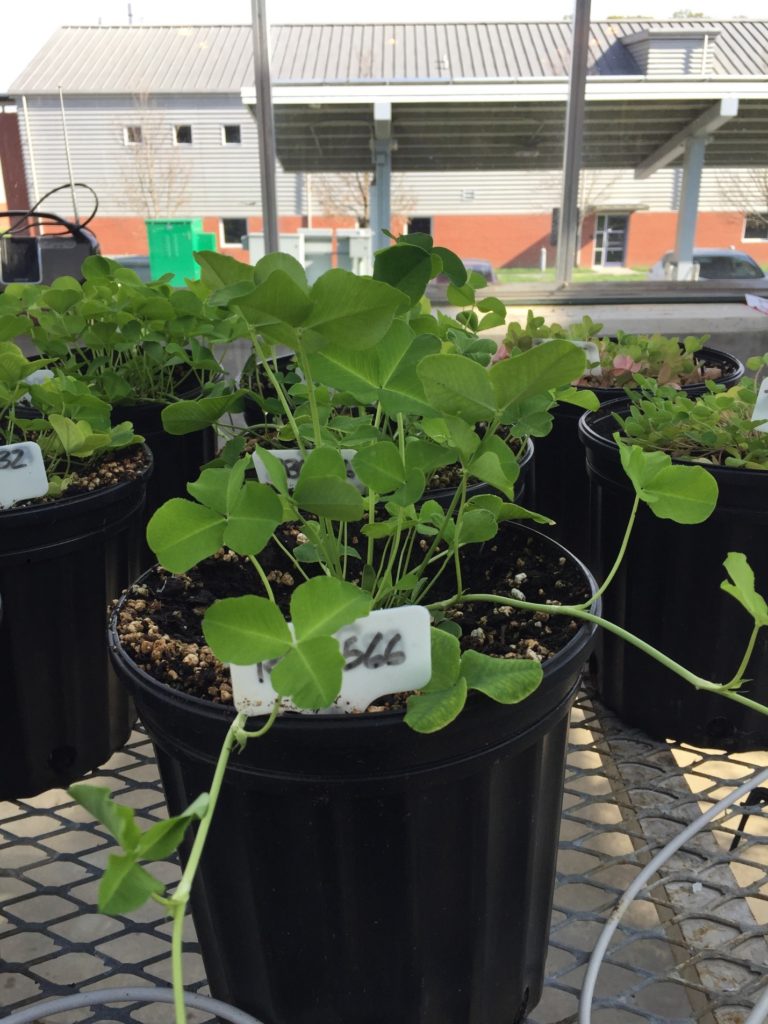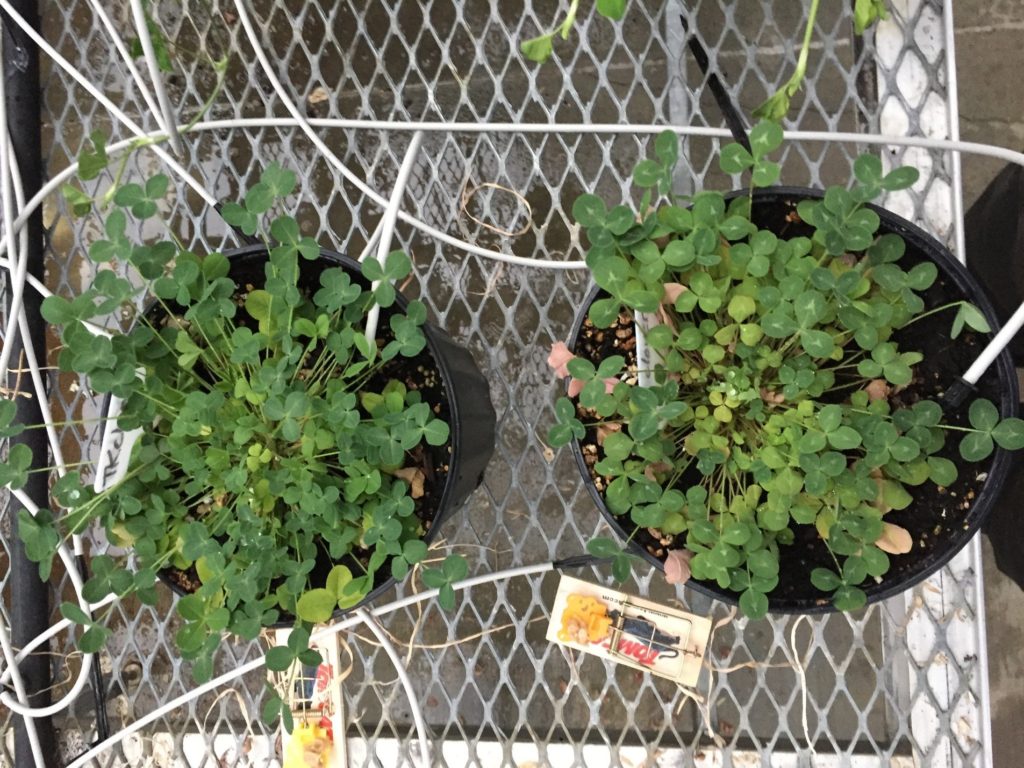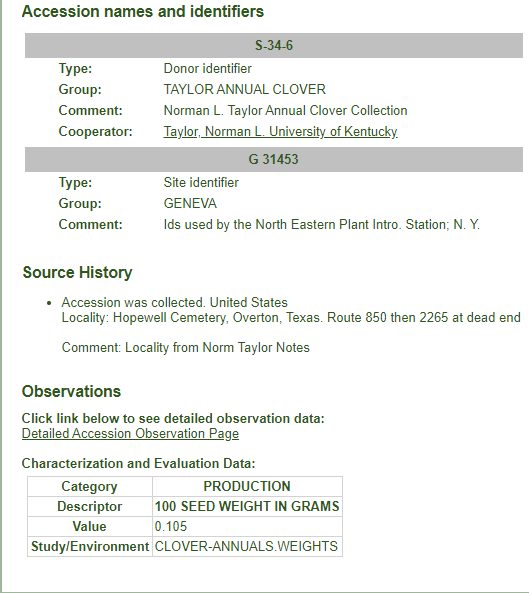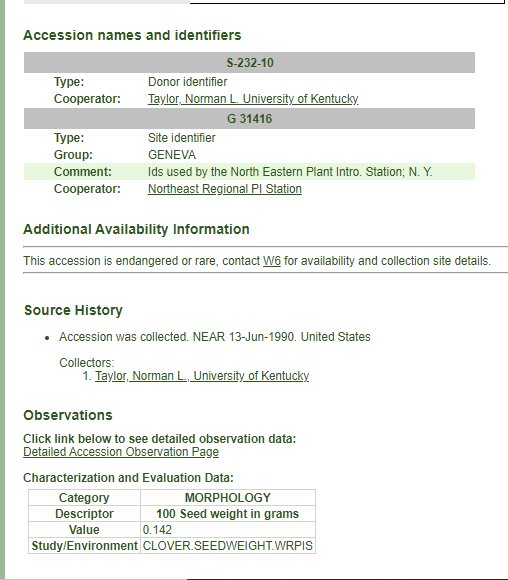Jonathan O.C. Kubesch, University of Tennessee
Clovers are an odd group of plants caught between agriculture and agronomy, especially in the Bluegrass. Agronomists and cattlemen find clovers important for their nitrogen contribution and nutritive value to livestock. Horse owners fear clover for the fungal pathogen behind slobbers. Wildlife managers use them for food plots. Of the roadside clovers, most came to Kentucky with settlers (Ball et al., 2015; Bryson and DeFelice, 2009). Those red and white clovers came with the tall fescue and Kentucky bluegrass. These species play an important role in Kentucky agriculture; however, the horse parks and cattle farms have replaced the natural ecosystems in the state (Noss, 2013; Campbell, 2014; Campbell, 2010).
In addition to these introduced species, Kentucky has three prominent native clovers: annual buffalo clover, running buffalo clover, and Kentucky clover (Vincent, 2001). Although collections of the native clovers have been made across Kentucky, it is really very uncommon to find these populations unless one knows where someone else has previously found it. It is unlikely that the reader will find these species in the local park or native area.
Annual buffalo clover (Trifolium reflexum), is spread throughout most of the eastern United States. The beautiful blooms have led to its potential as a horticultural species (Quesenberry et al., 2003). Of the native clovers, the genetics of the flowering in annual buffalo clover have been the most explored: red, white, and pink flowers (Quesenberry et al., 2003). At one point, it was favored over naturalized white clover in unimproved grazing lands (Killebrew, 1898).
Running buffalo clover (Trifolium stoloniferum) is a perennial species limited to the Ohio River Valley and Missouri. Plants spread on thick runners like strawberries. The species was investigated as a potential forage in the 1990s, and has been the subject of interest for herbivory dynamics in the eastern United States. The thick seed coat requires scarification in order for the seed to germinate (Kubesch, 2018; Sustar, 2017). Hoof action has been proposed as a driver in the ecology of the species, but a general disturbance regime seems necessary for the species to persist in the landscape (Kubesch, 2018). With some sandpaper and a few hours of free time, seed can be scarified. Running buffalo clover grows readily in the greenhouse.

Kentucky clover (Trifolium kentuckiense) is akin to annual buffalo clover in appearance, but found only in 2 sites within the Bluegrass (Chapel and Vincent, 2013). This last species is a recent discovery, and teeters on the brink of extinction in the wild. In the greenhouse the species is more difficult to propagate than running buffalo clover. Kentucky clover is a very newly described species and only found in the two locations known to date.

Luckily, Kentucky has a history of clover conservation. Private scientists, such as Dr. Julian Campbell and Dan Boone, and state agents, like Tara Littlefield, Joe Lacefield, and Heidi Braunreiter, monitor these species at all levels of the conservation paradigm. In addition, Kentucky has a favorable regulatory environment to improve seed banking and university research. Dr. Norman Taylor, University of Kentucky, built the original global collection of clover accessions in Lexington. Dr. Taylor went above and beyond the usual scope of agronomic collectors (Taylor, 2008). He maintained seed from Kentucky’s native clovers as well.
Since his death in 2010, his collection is now split between two USDA germplasm centers in Pulllman, WA and Griffin, GA. These seeds are available to professional researchers and citizen scientists. An important note known to Dr. Taylor’s successors in plant breeding, but absent in the literature, is the accession labelling scheme. When these seeds were in Lexington, the accessions were labelled in this fashion: S-232-9. To translate, S-232-9 is the 9th accession of species number 232 in the original collection (Ken Quesenberry, personal communication). Seed with this label trace back to the greenhouse benches. An issue in clover conservation is the provenance of these accessions. Some of these seeds may tie back to extirpated populations and represent genetic diversity preserved elsewhere. This problem of provenance is exacerbated in running buffalo clover, though not present for annual buffalo clover.
Table 1. Collection Notes for T. reflexum, annual buffalo clover, from USDA GRIN
| USDA Accession | Norm Taylor Identifier | Species | Locality |
| PI 650856 | S-34-6 | Trifolium reflexum Annual buffalo clover | Overton, TX Hopewell Cemetery |
Figure a. Accession notes for S-34-6 (T. reflexum). Screengrab from USDA GRIN.

Figure b. Accession notes for S-232-10 (T. stoloniferum)

Kentucky botanists and land managers have worked to preserve these native clovers in the Bluegrass Region. Floristics work, invasive species removal, and controlled disturbance have improved the fate of running buffalo clover. Kentucky clover is in the ICU right now, but a recovery team is at work addressing all the questions involved with this recent addition to the flora. The disturbance dynamics and herbivory history in the eastern United States have led to speculation on the booms and busts in the clover populations. Botanist Paul McKenzie put it best: “here today, gone tomorrow.” (Paul McKenzie, personal communication)
In order to understand some of the plant conditions in these habitats, I took some of the forage tools from the pasture to the Bluegrass woodland. After all, developing a quantitative measure for a cattle farmer should make it easier to save these little plants. In forages and grazinglands, we look at the amount of forage mass (vegetation herbage) and soil to track growth for livestock and wildlife (Allen et al., 2011). Forage measurement tools also provide ways to measure these plants without ripping up a fair deal of habitat. And, in addition to floristic comparisons, we can identify comparable places to put plants back in the wild. This closes the gap between producing seed and learning about the habitat.
In May 2019, I joined the Kentucky clover recovery team on a survey of sites in the Bluegrass Region. We looked at sites in Woodford, Franklin, Fayette, Jessamine counties to look at existing populations of running buffalo and Kentucky clover. In addition to surveying and botanizing, I went out with a rising plate meter (RPM) and a soil probe to get measurements on the herbage and soil fertility. A rising plate meter is a nondestructive tool that measures vegetation by compressing it to a uniform density and giving a unit of the compressed height. A rising plate meter floats on top of vegetation and is calibrated using several 1-ft2 quadrat samples. From the calibration, the forage mass of the RPM can be developed. The advantage of this technique is that it doesn’t require defoliating clovers trying to reproduce nor does it harm plants while sampling. I took my samples home to the Middle Tennessee AgResearch and Education Center (Spring Hill, TN) where I processed them. I dried the herbage samples to figure out their dry weights for my RPM calibration and compare to agronomic systems and natural areas, using the same procedure as described in Kubesch et al. (2020). I took traditional soil samples to 6” to get values for P, K, and other soil ions. I textured my soil samples by feel to determine the general textures these clovers occur on (Ritchey et al., 2015). These measurements are a snapshot of these sites when native clovers are actively-growing. I looked at patches with and without clovers growing. Is there a difference within sites?
I ran statistics in SAS to produce a report for the Office of Kentucky Nature Preserves and the Society, which I have submitted separately. From my analysis, these clovers grow in pockets of the site where there isn’t a lot of forage. This translates to vegetation: they are not covered in competition from other plants.
Table 2 (or Figure 2). Forage mass (kg/ha) of Bluegrass Clovers.
| Site | Clover | Forage Mass (kg/ha) |
| Ashland | Present | 957 |
| Ashland | Absent | 1406 |
| Buck Creek | Absent | 474 |
| Buck Creek | Present | 799 |
| Camp Pleasant | Absent | 1112 |
| Franklin | Present | 1309 |
| Franklin | Absent | 1607 |
| Jessamine | Absent | 1467 |
| Woodford | Absent | 361 |

Clovers grow in patches of habitat with less forage mass. The soil tests show that these sites have high P and K, and it appears that the clovers grow in Fe rich pockets. Work from Eastern Kentucky University and the Ohio State University have detected edaphic trends previously (Watt, 2011; Hattenbach, 1996). There is no significant association between forage mass and soil nutrient status, suggesting a paradox of low forage mass in high soil fertility. This snapshot of these habitats should help Kentucky to continue a great interdisciplinary tradition of clover conservation.
The proof of concept for using a rising plate meter in understory vegetation is a step forward in management. In addition to florisitics, more site area can be represented in assessment of existing populations as well as identification of potential reintroduction sites.
Table 2/3. Soil textures of habitat patches for Bluegrass clovers.
| Site | Clover | Soil Texture |
| Ashland | Present | Clay loam |
| Ashland | Absent | Sandy clay loam |
| Buck Creek | Absent | Sandy clay loam |
| Buck Creek | Present | Sandy clay loam |
| Camp Pleasant | Absent | Clay |
| Franklin | Present | Sandy clay loam |
| Franklin | Absent | Silty clay loam |
| Jessamine | Absent | Clay loam |
| Woodford | Absent | Sandy clay loam |
Seedling characters for clovers are important. At the Woodford county site, Kentucky clover is growing alongside red clover. The team may have a lead on discerning these species as seedlings; however there’s a fair deal of plasticity in red clover. Norm Taylor bred Freedom! red clover without pubescence. However, unimproved varieties often are fuzzy like Kentucky clover. Future students should consider solving this question.
Finally, these results suggest that the native clovers developed with grazing dynamics. It seems that herbivores played a role in the Bluegrass presettlement. These clovers persist where these isn’t a lot of plant material present, in pockets of high fertility, and where they can either send out stolons or seed to continue their species. While we have lost the Eastern elk and bison of Daniel Boone’s era, cattle may be part of the solution (Noss, 2013). Figuring out a controlled grazing strategy may help these plants in their main period of growth, while not harming their reproductive efforts (Becus and Klein, 2002). In running buffalo clover, mowing management has aimed to avoid harming seed set. Woodlands provide little forage to livestock and traditional wisdom suggests that heavy grazing pressure will harm the trees and understory plants. Controlled or rotational grazing timed around clover phenology may provide the necessary competition control for these species and improve seedling recruitment.
Acknowledgements
This work was funded by the 2019 Kentucky Native Plant Society Student Research Grant. Special appreciation is given to reviewers Kenneth H. Quesenberry and Michael A. Vincent.
Thanks to all members for supporting this opportunity. Thanks to my advisor, Dr. Renata Nave, for allowing me to pursue this project. Thanks to the Middle Tennessee AgResearch and Education staff—Joe David Plunk, Kevin Thompson, and station crew—for allowing me to use plot facilities to process samples.
References
Allen, V.G., C. Batello, E.J. Berretta, J. Hodgson, M. Kothmann, X. Li, J. McIvor, J. Milne, C. Morris, A. Peeters and M. Sanderson. 2011. Grass and Forage Science 66(1): 2–28.
Ball, D.M., C.S. Hoveland, and G.D. Lacefield. 2015. Southern Forages (5th Edition). International Plant Nutrition Institute (IPNI), Peachtree Corners, GA.
Becus, M.S., and J.B. Klein. 2002. Mowing schedule improves reproduction and growth of endangered running buffalo clover (Ohio). Ecological Restoration 20:4 295- 296.
Bryson, C.T., and M.S. DeFelice, editors. 2009. Weeds of the South. Univ. of Georgia Press, Athens, GA.
Cambell, J.J.N. 2010. Rebuilding the Concept of Bluegrass Woodland. The Lady-Slipper Newsletter of the Kentucky Native Plant Society 25(1): 6-9.
Cambell, J.J.N. 2014. NOT a Savanna, the Bluegrass Woodland of 1775 was eutrophic and probably much browsed but little opened. Notes by Julian Campbell, Feb 2014, accessible from bluegrasswoodland.com.
Chapel, K.J., and M.A. Vincent. 2013. Trifolium kentuckiense (Fabaceae, Papilionoideae), a new species from Franklin and Woodford counties, Kentucky. Phytoneuron 2013-63: 1–6.
Hattenbach, M.J. 1996. Edaphic relations of an endangered plant, Trifolium stoloniferum Muhl. ex. A. Eaton. The Ohio State University, Columbus, OH.
Killebrew, J B. 1898. Grasses and Forage Plants: Part 3 – Meadows and Wild Pastures. Bulletins. University of Tennessee Agricultural Experiment Station. Knoxville, TN. http://trace.tennessee.edu/utk_agbulletin/490
Kubesch, J.O.C. 2018. Edaphic and morphological factors affecting running buffalo clover (Trifolium stoloniferum) ecology. Ohio State University. Columbus, OH.
Kubesch, J.O.C., R.L.G. Nave, S. Cui, A. Griffith, G.E. Bates, and D.M. Butler. 2020. Optimal forage species selection for southeastern transitional or low-input production. American Forage and Grassland Council Conference Proceedings. Greeneville, SC.
Noss, R.F. 2013. Forgotten grasslands of the south: natural history and conservation. Island Press, Washington, DC.
Quesenberry, K.H., J.M Mullaney, A.R. Blount, R.S. Kalmbacher, and J.G. Norcini. 2003. Characterization of physiological and morphological variability in buffalo clover germplasm. Soil Crop Sci. Soc. Florida Proc. 62: 66-69.
Ritchey, E.L., J.M. McGrath, and D. Gehring. 2015. Determining Soil Texture by Feel. Cooperative Extension Service, University of Kentucky College of Agriculture, Food, and Environment. Lexington, KY.
Sustar, E. 2017. The effects of scarification on germination rates of running buffalo clover. Ohio State University, Columbus, OH. Unpublished Research Report.
Taylor, N.L. 2008. A century of clover breeding developments in the United States. Crop. Sci. 48:1-13.
Vincent, M.A. 2001. The genus Trifolium (Fabaceae) in Kentucky. J. Ky. Acad. Sci. 62(1):1-17.
Watt, L.A. 2011. Edaphic, Microtopographic, and Light Characteristics Associated with the Endangered Running Buffalo Clover (Trifolium stoloniferum) at the Blue Grass Army Depot, Madison County, Kentucky. Eastern Kentucky University.
Jonathan Omar Cole Kubesch is a graduate student pursuing a master’s degree in crop science at the University of Tennessee. He studied evolution and ecology—as well as agronomy—at the Ohio State University. He works on forages, grasslands, and prairies with a particular passion for native clovers.
